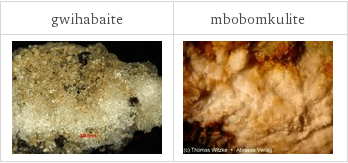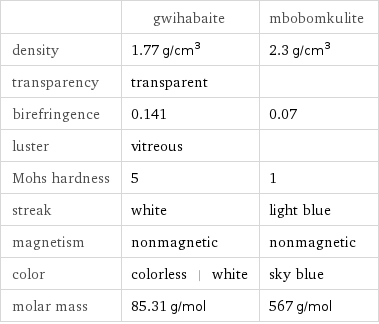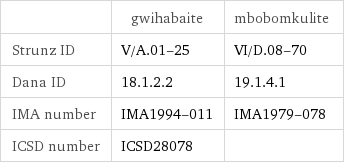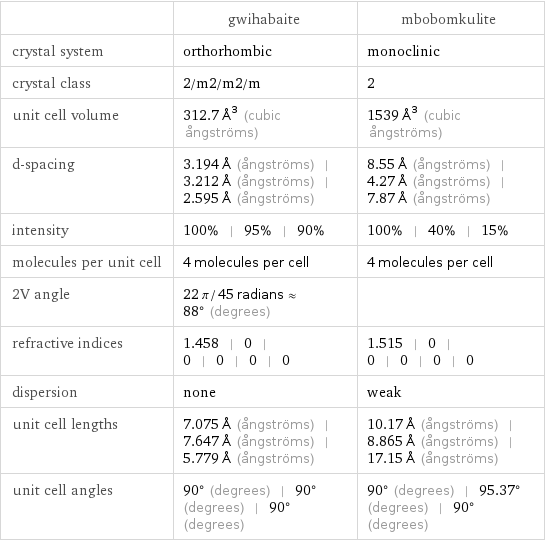Input interpretation

gwihabaite (mineral) | mbobomkulite (mineral)
Images

Images
General properties

| gwihabaite | mbobomkulite alternate names | nitrammite | (none) formula | (NH_4, K)(NO_3) | (Ni, Cu)Al_4(NO_3, SO_4)_2(OH)_12·3(H_2O) discovery year | | 1980
Basic properties

| gwihabaite | mbobomkulite density | 1.77 g/cm^3 | 2.3 g/cm^3 transparency | transparent | birefringence | 0.141 | 0.07 luster | vitreous | Mohs hardness | 5 | 1 streak | white | light blue magnetism | nonmagnetic | nonmagnetic color | colorless | white | sky blue molar mass | 85.31 g/mol | 567 g/mol
Units

Mineral identifiers

| gwihabaite | mbobomkulite Strunz ID | V/A.01-25 | VI/D.08-70 Dana ID | 18.1.2.2 | 19.1.4.1 IMA number | IMA1994-011 | IMA1979-078 ICSD number | ICSD28078 |
Crystallographic properties

| gwihabaite | mbobomkulite crystal system | orthorhombic | monoclinic crystal class | 2/m2/m2/m | 2 unit cell volume | 312.7 Å^3 (cubic ångströms) | 1539 Å^3 (cubic ångströms) d-spacing | 3.194 Å (ångströms) | 3.212 Å (ångströms) | 2.595 Å (ångströms) | 8.55 Å (ångströms) | 4.27 Å (ångströms) | 7.87 Å (ångströms) intensity | 100% | 95% | 90% | 100% | 40% | 15% molecules per unit cell | 4 molecules per cell | 4 molecules per cell 2V angle | 22 π/45 radians≈88° (degrees) | refractive indices | 1.458 | 0 | 0 | 0 | 0 | 0 | 1.515 | 0 | 0 | 0 | 0 | 0 dispersion | none | weak unit cell lengths | 7.075 Å (ångströms) | 7.647 Å (ångströms) | 5.779 Å (ångströms) | 10.17 Å (ångströms) | 8.865 Å (ångströms) | 17.15 Å (ångströms) unit cell angles | 90° (degrees) | 90° (degrees) | 90° (degrees) | 90° (degrees) | 95.37° (degrees) | 90° (degrees)
Wikipedia summary
Gwihabaite

Gwihabaite is a rare ammonium potassium nitrate mineral (NH_4, K)(NO_3). It is orthorhombic in form, colorless with a vitreous luster. It has a Mohs hardness of 5 and a specific gravity of 1.77. It is deliquescent and water-soluble. The mineral is also known as nitrammite. It was first described in 1996 for an occurrence in Gcwihaba Caves (Drotsky's Cavern, type locality), Maun, North-West District, Botswana. It occurs as incrustations and efflorescences on cave surfaces formed by bacterial action on bat guano.